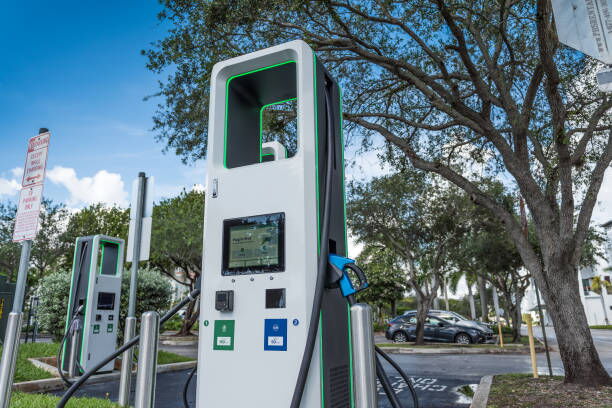Electric vehicles (EVs) are hailed as a crucial step toward reducing greenhouse gas emissions and mitigating the impact of climate change. Yet, as more drivers make the switch to electric, a pressing question emerges: How sustainable is EV charging itself?
The short answer is that EV charging is significantly more sustainable than traditional gasoline fueling, regardless of the energy source. While the current global energy mix remains predominantly fossil-fuel-based, renewable energy sources are rapidly gaining ground. Charging EVs with power from solar, wind, geothermal, nuclear, hydro, and tidal energy can significantly reduce atmospheric emissions.
According to the International Energy Agency (IEA), only 36 percent of the world’s energy currently comes from low-carbon sources, but that figure is climbing every day. The IEA projects that between 2022 and 2027, global renewable power capacity will surge by 2,400 gigawatts (GW) — roughly equivalent to the current total power output of China. This forecast is 30 percent higher than the agency’s predictions from just a year earlier.
Moreover, the IEA estimates that more than 90 percent of global electricity expansion in the next five years will come from renewable sources. This means the world is poised to add as much renewable power in half a decade as it did over the past 20 years. As renewable energy becomes the norm, powering EVs sustainably will drastically cut greenhouse gas emissions, pushing the transportation sector closer to carbon neutrality.

The surge in EV adoption creates immense opportunities for businesses to build sustainable EV charging infrastructures. However, success in this emerging market demands a holistic and strategic approach. Below are key practices to establish a sustainable, future-proof EV charging business.
In the business landscape, sustainability is synonymous with long-term success. Selecting the optimal site for your EV charging stations lays the foundation for a resilient operation. Here are some critical considerations:
Market Relevance: Choose a location that caters to your target audience now and in the foreseeable future. Busy commercial zones, highway rest stops, and residential areas with high EV adoption rates are ideal.
Scalability: The site should offer enough space for potential expansion. As EV adoption grows, demand for charging stations will escalate, making it vital to anticipate future growth.
Technological Flexibility: Infrastructure should accommodate evolving charging technologies. Future upgrades to faster and more efficient chargers should be feasible without major overhauls.
The installation of EV charging stations must be executed without disrupting existing business operations or compromising safety. Building with safety and serviceability in mind ensures not only operational continuity but also customer satisfaction.
Clear Signage and Safety Measures: During construction, guide customers safely around the site using well-placed signage. Providing alternative routes to your primary facilities helps maintain business traffic.
Maintenance and Service Accessibility: Design the infrastructure to facilitate easy maintenance, minimizing downtime. Charging stations that are difficult to repair or maintain can result in operational inefficiencies and revenue loss.
Data-Driven Safety Protocols: Leverage data from your charging network to predict maintenance needs and address potential hazards proactively.
Once your charging stations are operational, data collection and analysis become invaluable. Monitoring station performance, user patterns, and energy consumption can inform better business decisions.
Performance Metrics: Regularly evaluate key performance indicators (KPIs) such as uptime, energy usage, and transaction volumes. Identifying patterns and anomalies allows you to optimize performance.
Revenue Optimization: Understanding usage peaks and customer behavior helps maximize revenue through dynamic pricing models.
Energy Management: Implement energy-efficient practices and consider integrating renewable energy sources like solar panels to minimize your carbon footprint.
The rapid pace of innovation in the EV charging sector makes future-proofing essential. Stay ahead of technological advancements and industry trends to maintain a competitive edge.
Upgrade Capability: Design your charging network to allow for easy upgrades. This might include preparing conduits for higher-capacity wiring or reserving space for additional chargers.
Modular Design: Employ a modular approach that allows components to be easily swapped out or enhanced without disrupting service.
Interoperability: Ensure that your charging stations are compatible with various EV models and charging standards to accommodate diverse user needs.
Keeping up with industry developments is crucial for long-term success. Attending conferences, joining industry associations, and maintaining dialogue with thought leaders can offer invaluable insights.
Networking: Engage with industry experts to gain knowledge on best practices and emerging technologies.
Training and Development: Invest in training for your team to stay current with technological advancements and safety standards.
Regulatory Compliance: Regularly review local and international regulations to ensure your charging infrastructure remains compliant as standards evolve.
Sustainability in EV charging extends beyond just powering vehicles. Incorporating circular economy principles can further reduce environmental impacts. For instance, using recycled materials in charger production or implementing battery recycling programs contributes to a more sustainable ecosystem.
Furthermore, partnerships with renewable energy providers can ensure that charging stations run on clean energy, creating a closed-loop system that maximizes sustainability. As renewable energy grids become more robust, integrating on-site energy storage solutions can also improve reliability and reduce strain on the power grid during peak times.
EV charging presents a promising path toward a greener future. By strategically planning charging station placement, prioritizing safety, leveraging data, and adopting future-ready infrastructure, businesses can build sustainable and profitable operations. As the global push toward renewable energy intensifies, EV charging will play an increasingly vital role in reducing carbon emissions and shaping a cleaner, more sustainable world.
Staying ahead of industry trends and making informed decisions rooted in data and safety will ensure long-lasting success in the evolving EV landscape. The future of sustainable mobility lies not just in the vehicles themselves but in the infrastructure that supports them.